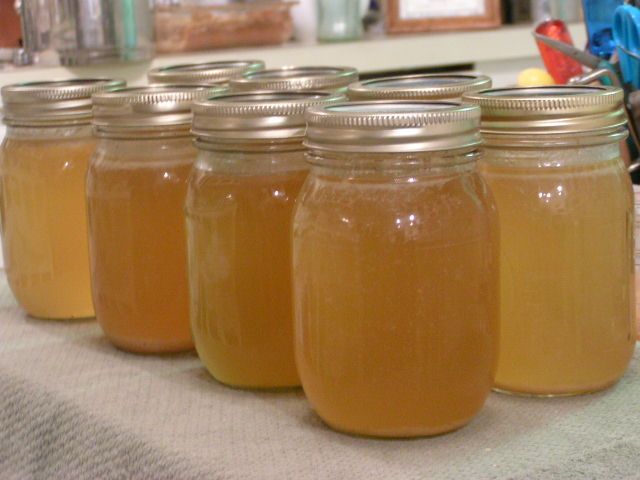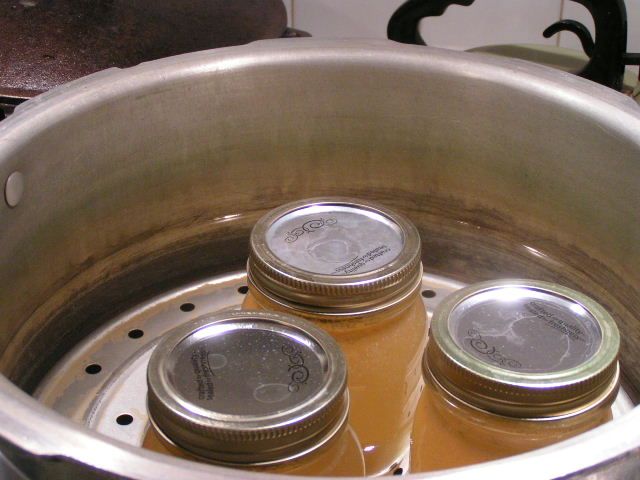 A reader of the very informative blog Rural Revolution, A. McSp, shared a wonderful recipe for chicken stock to be used for cooking pinto beans, soups – you name it. I decided to try it and am in love. First, the smell that permeates your house while cooking this stuff is enough to call Glade and ask if they make Chicken Stock in a Can Air Freshener, second, the flavor is so rich that it makes everything to which it is added have more body, and third, it’s canable – oh wait – that’s not a real word unless you’re talking about creepy hungry people and can’t spell. How about this: It can be canned! You know that always gets me right here (pointing to my heart now). I’m afraid that I was so involved in the process that I didn’t do my normal photo session and so I’m just going to have to give you the recipe with only a few photos and a video. Sorry for my brain freeze. I did get a couple of shots! Here are the steps to this amazing chicken stock! 1. When you cook a chicken, save the carcass, skin and all and if you aren’t going to make stock immediately, put it in the frig until you are ready, no more than a couple of days. 2. Cut or break the bones up into pieces using kitchen shears. 3. Put the bones and skin into a stock pot and cover with water, about a gallon plus. 4. Add 1-4 stalks of celery. I used my dried celery! 4 tbsp to equal 4 stalks. I love my dried celery! 5. Add 1/2 medium onion 6. Add 4-5 cloves of garlic 7. Add parsley if you have it 8. Add 1/2 tsp dill seed if you have it 9. Now here she said to add 1/2 tsp dried orange peel, but I didn’t have dried so I used 1 tsp of fresh orange zest. Oh my. I think I prefer that to the dried!! 10. Add 3 tbsp white vinegar and the juice of one half lemon or lime 11. Add salt and pepper to taste (side note: If you want an even more robust chicken flavor add 1/2 – 1 tsp granulated chicken bouillon per pint jar of stock) Bring to a boil and stew on low heat for two to three hours. The vinegar and the lime or lemon juice pull the calcium out of the bones and so your broth is rich in calcium. As the stock stews, I add a little water to maintain the water level. When the cooking time is reached, I pour the broth, bones and veggies into a colandar that is sitting over a large bowl or another stew pot, to strain the broth. I press the stuff left in the colandar with a potato masher to get out all of the liquid and flavor into the stock in the bowl. At that point, I ladel the soup into jars, leaving a 1/2″ head space, clean the rims of the jars, attach the lids and rings and put them into a pressure canner of hot water (the jars of liquid are hot and will crack in cool water) to be processed for 20 minutes at 10 lbs pressure. One chicken gives me 10 pints of broth.  Unlike waterbath canning, the water level in a pressure canner is only about 2″ deep.  The jars sit in the water, but are not covered by it as in a waterbath. I did a video of the pressure canner as it was doing it’s thing this afternoon. I’ve had several people ask me how it is supposed to sound. If you will notice, it jiggles for a bit and then stops and then jiggles and stops. That is the rhythm that you want to achieve to keep an even pressure. I start out on high heat and when the weight starts vibrating, I start turning the heat down until I get a uniform rhythm. I bought this canner in 1977! It has been a jewel. Pardon the noise of the microwave in the background. Halfway through I realized it and turned it off! Last night, I made pinto beans with two pints of broth, two tbsp brown sugar and a slice of home-cured country ham. Oh my. I’m still grinning. |
|
Oklahoma Pastry Cloth™ Company on Facebook
|
Tags: canning, canning broth, canning video, chicken broth, pressure canning video, recipe

I’m wondering why you process this so long…my Blue Book says pints 20 minutes, quarts 25 minutes at 10 lbs. pressure. I’ve done that for a couple of years with no trouble. Is there something I’m missing?
I also cook my broth for at least 12 hours…makes it so rich and more nutritious. By adding vinegar you’re pulling out the calcium and other minerals from the bones and suspending them in the liquid. It’s very nourishing, and the longer simmer time just makes it that much better! Just thought I’d pass that on. Great post…I just found your site and will enjoy looking at other posts! Thanks!
Hi Nancy. Thanks so much for your comments and observations. According to the newest, 100th anniversary Ball Canning Blue Book, all broths from meats require 1 hr 15 minutes to process. I know that my older canning books from my grandmother say to process broth for 60 minutes which is just a hair shorter. Simmering the broth longer before putting it in the jars sounds wonderful. I am sure it is REALLY rich. Will have to try that too. 🙂
Well…I’m confused. I checked my daughter’s Blue Book (also the 100th Anniversary edition). On p. 63 (Chicken Stock) it says process pints 20 minutes and quarts 25 minutes. I’m sure not trying to nit pick, but want to make sure I’m not under processing. Where are you finding the hour and 15 minute instructions?
I can broth every few weeks after saving chicken carcasses till I have 2-3, so you can see my keen interest here! 🙂 I can 8-10 quarts and freeze or use whatever is left. I use it in everything…cooking rice, beans, soups, etc. Here’s a great article on the health benefits of slow simmered broth.
http://www.westonaprice.org/food-features/515-broth-is-beautiful.html
Oh my gosh! You are right, Nancy. I’ll blame it on my bifocals. Did you notice right under it? Chili. That starts with a CH too, right? 🙂 My Farm Journal cookbook from the 50’s says 60 minutes so I don’t know who to believe!! I like the 20 minutes part. 75 is a looooong time. Thanks for pointing it out. I will change it on the post. I will say, however, that you can bet your bippee that my stock has NO little critters in it because they got cooked to death. 🙂
Haha…I’m just relieved that MY lenses are working…and that I’m not losing my mind! 🙂 I do usually process my quarts for 30-35 minutes though, but that’s still a far cry from 75. No, I bet there aren’t any critters left around after 75 minutes!
Okay…have you ever canned dried beans? I started that a couple of years ago as well, and have absolutely loved having them on hand. The process I use is sooo easy. I found an obscure chat comment from a woman who said she’d canned them for years by placing 1 cup of washed/sorted dry beans in a jar, filling it with water and soaking overnight. In the morning, drain the water, add 1 teaspoon salt and fill with boiling water (or broth), cover with lid and ring and process at 10 lbs. for 90 minutes. Really wonderful, and much easier than cooking them first.
I’ve got 6 lbs of butter ready to can, and 15 lbs. of cheese coming in my co op order. I have to say…I’m enjoying canning more than just my summer garden produce.
Blessings!
Nancy, I do can dried beans, but have not tried it the way you have suggested. That sounds soooo much easier. I think I’ll just try that and it’ll make a good blog post. Will attribute it to you! Thanks for the directions.
Canning IS fun, isn’t it!
[…] you have processed the main pieces, you can boil all of the leftovers into the stock found in this previous post. Happy […]
[…] and add rings. Tighten slightly. Place in a pressure canner just like I demonstrated in the post on canning chicken broth. Process for 75 minutes once your canner has pressurized. I have to admit that of all the things […]
[…] quarts chicken broth (I use my home canned broth but you can used […]